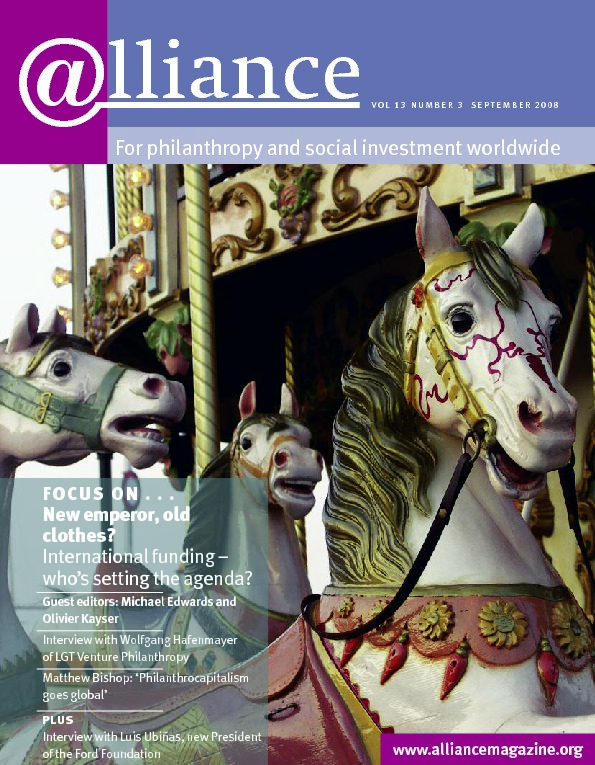 Stock markets worldwide continue to be in turmoil, so it is premature to start talking about any lessons learned during the financial crisis of the past year. Certainly, a more active regulatory presence might have helped. But what hasn’t changed is the need for transparency and information about investments. Investors can begin to feel confident in social investments only if there is complete information and total transparency. After the market turbulence of the last year, no one really knows what it’s going to take for investors to regain confidence.
Stock markets worldwide continue to be in turmoil, so it is premature to start talking about any lessons learned during the financial crisis of the past year. Certainly, a more active regulatory presence might have helped. But what hasn’t changed is the need for transparency and information about investments. Investors can begin to feel confident in social investments only if there is complete information and total transparency. After the market turbulence of the last year, no one really knows what it’s going to take for investors to regain confidence.
Social investments are no different from traditional investments. The more information and transparency provided, whether it is a public or a private offering, the more sure investors can be about investing their money. But where social investments differ is in the need for information and transparency in reporting their impact. This is not so simple. Every social investment has a different impact, and the way it is measured varies investment by investment.
Despite the problems of the past year, this is where publicly traded investments can be a model. Regulatory agencies, such as the Securities and Exchange Commission in the US, ensure that all public companies report all information in a timely manner. They standardize the information so that results can be fairly compared. Social investments have no such agency, which makes it impossible for an investor to quickly compare the impacts of different social investments.
But some organizations, including Investing for Good in the UK and Social Impact Research in the US, are applying their own methodologies and analyses to these investments to enable investors to easily compare their impacts. The problem is that the information is not standardized and few firms are rating the investments.
Here at Investing for Good, we act as an intermediary between investments and investor. We believe that potential investors deserve the most accurate and complete information available. To that end, we compile all information, research the offering, write a report, and rate the investment.
When preparing our own analysis and ratings, we compile a comprehensive body of information and use this to score each investment in the three crucial areas of confidence, return and impact. Confidence relates to the financial stability of the investment.
Prominent scoring criteria here include the operational strength of the organization, as well as management, operating history and relevant risk factors. Return measures the projected financial return. Impact assesses the social and environmental benefits generated by the investment, which are measured and analysed with respect to the company’s stated mission as well as, crucially, its target stakeholders. Where traditional equity research would look at the financial results alone, our Impact Investing Analysis Methodology looks at the complete picture of the social investment.
Similarly, Social Impact Research, a division of the non-profit Root Cause, models its research reports on private sector equity research. Its reports aggregate and analyse information from the companies themselves, but also from government agencies, grantmaking organizations, think-tanks, academics and consultants.
Later this year, the Acumen Fund in the US will launch its own Portfolio Data Management System, created in collaboration with engineers from Google. The system will compile financial, operating, social and environmental performance results at both the portfolio and the sector level, but it will not rate the investments.
The Nonprofit Marketplace: Bridging the information gap in philanthropy, a report written by the Hewlett Foundation and McKinsey & Co, concludes that philanthropic ventures, which it describes as ‘the nonprofit marketplace’, have much to learn from traditional capital markets. The report concludes: ‘The nonprofit marketplace lacks the robust flow of timely, accurate information that is a hallmark of high-performing markets such as stock exchanges, commodity markets, or eBay. To bridge this gap, the sector must capture, analyze, distribute, and use information on nonprofit organizational performance and social impact more effectively.’
As the late Anita Roddick, founder of the Body Shop, said: ‘I want something not just to invest in. I want something to believe in.’ Investors will have something to believe in only if they have confidence in the information they have.
Maureen Stapleton is an analyst at Investing for Good. Email mstapleton@investingforgood.co.uk
Investors’ perspectives is produced in collaboration with Investing for Good, a social finance intermediary and asset manager founded in 2004.
http://www.investingforgood.co.uk





Comments (0)